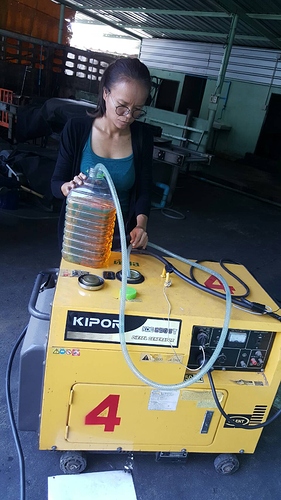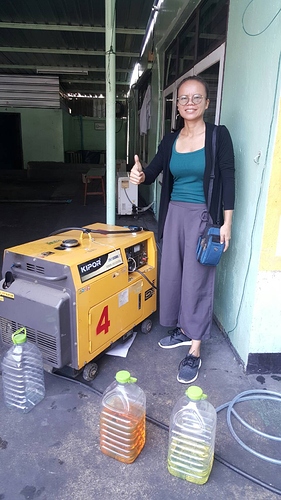I guess this “pyrolyisis oil” is what the closest US forest products lab calls “pyroligneous acid”. Isn’t that the stuff that goes up the chimney of a wood burning stove? From a combustibility standpoint, I can tell you that it certainly does burn when dried, as in chimney fire. Our rule of thumb was to keep the chimney temp up to at least 250°F at the top to keep it from condensing on the chimney walls. Someone once told me that it may have as many as about 300 ingredients in it.
Cleaning up areas where it has been sure is a time consuming thing.
I seem to have observed that it will etch glass. Seems like quite a mix of chemicals. I can see it as potentially a good chemical feedstock, and I imagine different processes will vary the output, but to use as anything but a direct fuel, or wood treatment I suspect would require chemical processing.
Sliding toward OT:
Some of the compounds appear to be almost carcinogens; creosote, for example. Although most creosote seems to be made from coal these days, I guess some comes from wood, or did once upon a time. I appreciate this thread. It made me do some googling, which did get me off track a bit, but it was interesting to see how the world’s health scientists have been going back and forth on whether this or that chemical is carcinogenic or not. Did you know that Finland has 10,000 km of creosote treated wood posts sunk into the waters to control where the water can and can not go?
Pete Stanaitis
I believe creosote has the legal definition of being made from coal in the US. It is kind of like ‘activated carbon’ had a legal definition where it had to be sourced from FF sources. I think they changed that one though.
Gasoline is made up of like 200 different compounds as well. But yes, if you start looking at it closely, you start to see some creepy chemicals. Pyrolosis oil has a bunch of Oxygen groups and aromatic compounds.
The EU was considering outlawing pine tar, made from pyrolysis distillation of pine stumps, which has been traditionally used to treat ropes and wooden boats. The powers that be had concerns about some of the compounds. Not sure if the scientific view changed, or the politics got too hot, but last I heard it was still allowed.
Yes, Gary. I ran across a lengthy article on that very topic.In the end (of that current session), it was a pretty close call between bad and not bad for creosote as being dangerous to humans. As usual, a lot of rats got it during those tests.
Sean- I am sure that crude oil may contain 200+ compounds, but I thought gasoline covered a much smaller range of hydrocarbons in the C7H16 through C11 H24 range (plus whatever is the additive of the day). And, they are all pretty much in the same family, whereas the pyrolysis oil has contains a wide range of non-hyrocarbons.
Pete Stanaitis
Consider this:
If you use cooking oil to hot, it burns and forms “dangerous” byproducts
Same goes for Wood vinegar or bamboo vinegar…
closed retort and controlled temperature rising, then you can get “clean” distillating products…
just don’t “burn” your cooking…
It is mostly straight alkanes, but they have other crap in there as well. The refining process is a distillation process. Anything in the oil that recondenses at like 100C-200c is your straight run gasoline. then diesel is like 200-350C, then fuel oil is 350-400C, etc. I don’t recall the exact temp ranges but that is the general idea. they will also crack some of the heavier alkanes to try and get smaller sizes, which I think falls under reformulated gasolines.
To find what is in the wood gas make up it might be a good idea to look at the gases from a prehydrolisis cook on wood in a digester at a paper mill… The prehydrolisis cook is used on dissolving pulp cooks for wood pulp that will be processed by into other products by a customer.(cellophane or other acetates and pulp dissolved by caustic soda.) Prehydrolisis cook was like a pre-boil of the wood chips with no chemicals to help break down lignins in the wood. This released a lot of the sugars to be vented, as the heat comes from superheated steam injection.
I do not know where on the web to research these gases from the cooking of wood, but, will look. I worked at an International Paper pulp mill for 17 years. It closed 14 years ago and I have thrown out all of my old books concerning cooking and cleaning the pulp.
I also worked in the power house working the recovery boilers(we burned the wood solids out of the liquid chemicals to recover the chemicals).
liquid diesel Fuel from Bamboo… works as a charm
I had these on my facebook Redirecting...
and now these from testing today…
The light color is standard diesel fuel… the orange is the bamboo diesel fuel…
Koen that is impressive I have never seen diesels run on anything besides biodiesel made from veg oil. After looking into the chemical process of making biodiesel I decided I didn’t want to expose myself to the risk of the outgasing so I never went down that road. I do debate setting up one of the heating systems to thin veg oil but haven’t tried it yet.
Anyway I know you have been working on this for a while congrats on getting it up and running.
Hi Koen
the fuel “biodiesel” is obtained by distiation of bamboo vinegar?
Thierry
Hi Thierry,
Combination from different processes, including the wet gas condensation and the gas reforming from the charcoaling process.
Lets say, its a little more complicated then DIY but actual not overcomplicated…
Think off breaking the big puzzle into small puzzles and then solve them one by one and recombine…
i call it reverse engineering from how crude oil gets developed…
replicating many natural processes
its easy if you have an outlet for waste energy or if any process waste can be used as a source of energy for other purposes.
goal is to have a basic raw wood gasification system and then drain about 10% as useable fuel other then woodgas.
i am, or, we are, not trying to make profit with consumer products, but rather build industrial friendly technology to be used and let the industrie contribute to education for the benefit of the industry and the rural farmers.
so we have 2 style’s: Industrial and farmer
Both to be do able “organic material only” ( aka biomass and biomass waste )
Imagine what could be done if we could combine all the knowhow from the members of DOW… life would be green, life would be good…
Very nice Koen.
How many pounds of bamboo did it take to make what you have there?
Also, don’t diesel engines typically require a fuel return line?
Hi Bill,
we just drained the tank from the ordinary dyno diesel and refilled with bamboo diesel.
so, yes, this generator has a return line for fuel 
a rough estimate in the process amount would be about 6% from the amount of bamboo turned into diesel.
But all the other 94% are used as fuel for other purposes and energy needed for the process comes from waste energy from those other processes.
so much you can do if you can combine…
numbers i play around with:
2000 Kva electric supply
200 Kwh solar plant
18 Mw heat from boilers
500 CBM methane from waste water biodigester
i used last year , for the heating process, 25.000 ton of woodshavings
and about 1.200 cbm heavy oil
now , with some knowhow installed, its running average 15% more efficient…
why did you choose biodiesel synthesis instead of alcohol? Our vehicles converted to wood gas hybridize well with alcohol !
Hi Thierry,
The diesel is only one of the products i test… plenty things going on here, not to worry if i forget alcohol 
This reminds me of looking in to using oat hulls to produce furfuraldehyde. back in the late 1970’s. Quaker Oats had a big market for it as a chemical intermediate for the magnetic tape backing industry until polyesters became available.
The samples we got didn’t run in a diesel engine but would run in a preheated gasoline engine (an old John Deere B that had a separate “Tractor Fuel” tank).
One of the organic chemists where I worked suggested that adding a small percentage of ethanol to the furfuraldehyde ought to make it run in a diesel.






